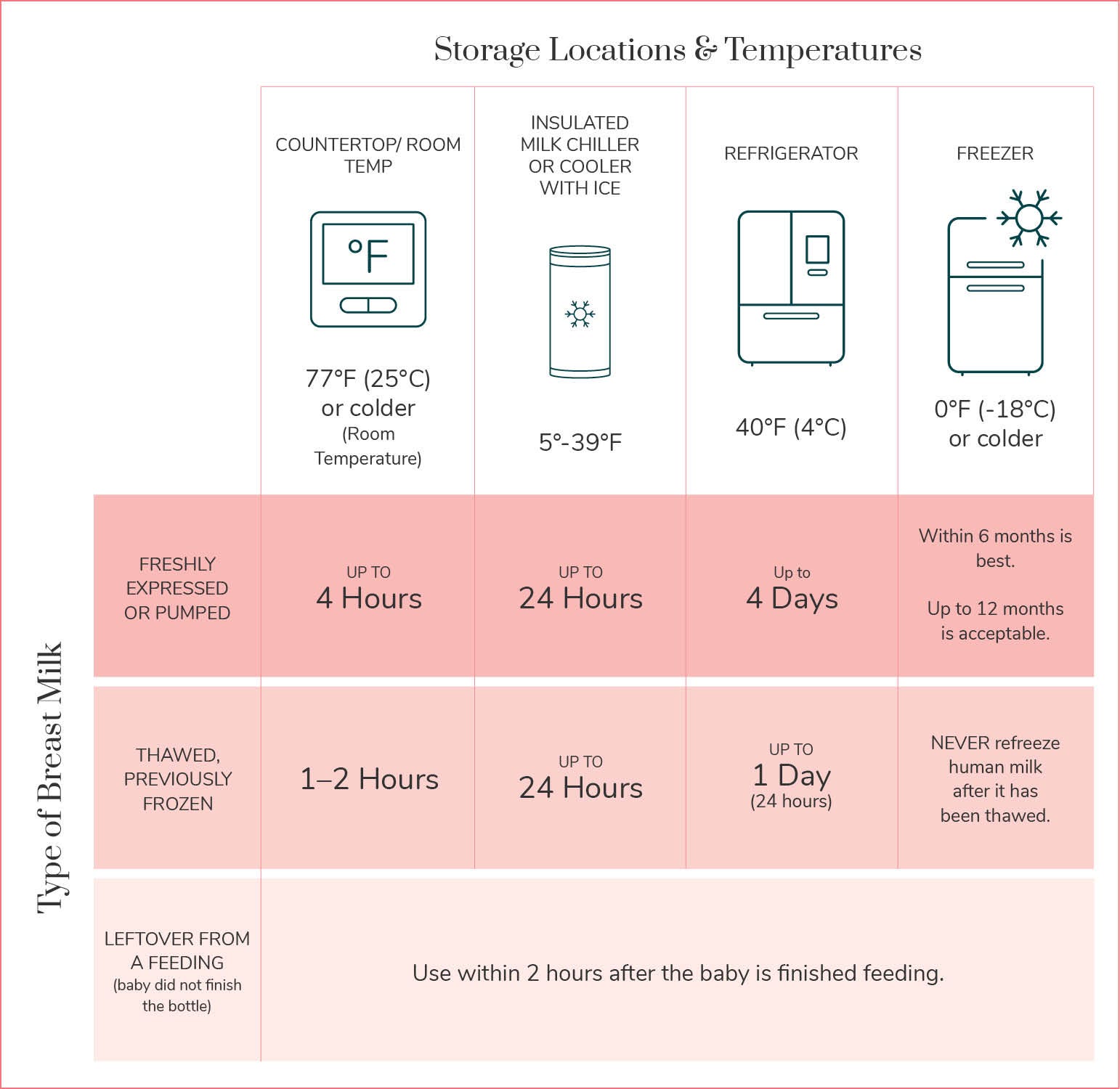No two pumping sessions are alike. Every mama has a unique body that is constantly adapting and changing to the needs of their babies and as part of their own healing process. You may find that some pumping sessions yield a lot of milk, and others produce very little. You may find that one breast produces more milk than the other, and that baby prefers one over the other too. This is all completely normal, but the unpredictability can certainly feel frustrating.
While your body and milk production may be unpredictable, there are great breast milk storage options that can help you make the most of every drop you produce.
Read on for a comprehensive guide to breast milk storage.
How To Store Breast Milk: The Basics
Getting ready for a pumping session? Start by washing your hands and sterilizing your equipment. Next, think about when you want to use the milk.
Already have a fridge full of milk? Consider freezing your breast milk for future use.
Here are the basic steps for storing breast milk in the fridge or freezer.
Storing Breast Milk in the Fridge
- Only use containers that are BPA-free, food-safe, and have an airtight seal.
- When storing breast milk in the refrigerator, be sure to store it as soon as possible.
- To combine a new batch of breastmilk with a refrigerated batch, cool your breastmilk in the fridge in a different container until it gets to the same chilled temperature as your other refrigerated breastmilk. You can add cooled breast milk to your storage containers over time but do not add body-temperature milk.
- Place your milk at the back of the refrigerator, at the coldest part, and away from the door where the temperature may vary.
Want a longer-term storage option? You can also freeze your breast milk.
Storing Breast Milk in the Freezer
- Only use containers that are BPA-free, food-safe, and have an airtight seal.
- Freeze breast milk by placing it in the freezer as soon as possible after pumping.
- Expressed breast milk may be added to frozen milk if it has been cooled in the refrigerator first. Do not add room temperature milk to frozen breast milk.
- Don't fill your bags past the 3/4 mark. This is because breast milk expands as it freezes.
- Place your milk at the back of the freezer where the temperature remains the most consistent.
- Avoid placing your breast milk by the freezer door where it may thaw due to varying temperatures.
- Storage tip: Lay bags flat in the freezer. Once they’re frozen, you can store multiple bags of frozen milk together in a gallon freezer bag to save space.
- You can store breast milk in the freezer for up to one year, but use within 6 months is best.
- Never refreeze breast milk after it has been thawed.
Breast Milk Lifespan
Understanding breast milk lifespan and the best storage methods is critical to ensuring your milk is safely stored and available to your baby when needed. The lifespan of freshly expressed breast milk varies from one storage method to another because of the relationship between temperature, exposure, and bacterial growth.
How Long Can Breast Milk Be Left at Room Temperature?
According to the CDC, freshly pumped breast milk can be stored at room temperature for 4 hours. It should always be covered in a safe storage container and kept as cool as possible. Do not freeze fresh milk after it’s been left at room temperature for more than four hours.
How Long Can Breast Milk Stay in a Cooler?
After expressing milk, you can store it in a cooler or insulated cooler bag with ice packs for about 24 hours. The temperature of your cooler will determine if it will be safe to freeze your milk (the colder, the better). Freeze your breast milk within 24 hours of chilling it.
How Long Does Breast Milk Last in the Refrigerator?
You can store your milk in the fridge for up to four days.
How Long Does Breast Milk Last in the Freezer?
You can store breast milk in batches in the freezer for up to 12 months. Though use within six months is best. Thawed breast milk should be discarded after use. Do not place it in the fridge or refreeze it.
Whichever storage method you choose, it’s always important to:
- Label your breast milk with the date and time it was pumped to keep track of what’s fresh. It’s important to note that the makeup of breast milk varies depending on the time of day. Morning milk has a higher rate of cortisol, the stress hormone, which helps you wake up. Evening milk has melatonin, a calming hormone that helps you fall asleep. Knowing what time you pumped will help you ensure that you don’t give your baby “wake up” milk in the evening, and vice versa.
- Frequently clean out the fridge and freezer to discard milk that exceeds the time limitations provided.
Combining Breast Milk from Different Pumping Sessions
It’s not unusual to sometimes have to combine breast milk from different pumping sessions for your babies’ supplemental bottles. This may be necessary when you experience changes in your milk supply.
Here are some common questions and responses regarding combining breast milk from different pumping sessions.
Can I Combine Milk That I Pumped on Different Days That Has Been Stored in the Fridge?
As a rule of thumb, all milk should be clearly labeled and kept in the fridge no longer than four days before being consumed or frozen. If you combine breast milk from different days, be sure to cool your fresh breast milk before adding it to the previously refrigerated milk.
Make sure the container of combined milk is labeled with the date the older milk was pumped. Store it in the freezer if the oldest milk was pumped more than four days ago.
Can I Combine My Breast Milk with Milk from Someone Else?
We recommend that parents use caution when giving their babies pumped breast milk that has been donated by family members, friends, and acquaintances, and to totally avoid purchasing donated milk that does not come from a human milk bank.
If you choose to use donor milk, make sure to label the milk with the date and time pumped. If you want to combine your breast milk with the donor milk, be sure to cool your fresh breast milk before adding it to the previously refrigerated donor milk. Label the container of combined breast milk with the date the older milk was pumped.
Can I Combine Freshly Pumped Milk With My Breast Milk That Had Previously Been Frozen and Is Now Thawed?
Yes, this can be done. If you are going to use the freshly pumped and thawed milk right away, you can mix the milk and use it immediately. If you are planning on storing the thawed and freshly pumped milk, cool your freshly pumped warm milk before combining it with the previously frozen breast milk to prevent the previously stored cold milk from warming up too much, which can trigger bacterial growth.
If There Is Breast Milk Left Over in My Baby’s Bottle After Feeding, Can I Combine This Leftover Milk With Milk I Previously Pumped?
It is not recommended to combine milk that is left after a feed with other milk due to a risk of bacterial contamination of the milk that is left over in a bottle.
Thawing and Warming Up Breast Milk
How Do I Thaw Frozen Breast Milk?
As Nicole Peluso, a board certified lactation consultant and our Manager of Lactation Services and Education, shared with Care.com, when it’s time to thaw breast milk, it’s important to select the right milk to defrost:
“First in, first out is the best motto for which milk to choose; this means picking the milk that is the oldest. This ensures that, long term, the baby is using up milk systematically so you don’t have any milk sitting in your freezer that is really old.”
There are two different ways to safely thaw frozen breast milk:
- Remove it from the freezer and place it in the fridge. Thawing frozen milk takes about 12 hours. It’s recommended to place thawing milk in the fridge the night before you plan to use it.
- Hold the breast milk collection container under lukewarm running water to warm it evenly. Once thawed, swirl the milk with your finger to ensure the temperature is consistent. This will also help to mix the creamier layer on top with the watery layer on the bottom.
Never thaw breast milk by microwaving it as this could cause uneven hot spots that burn your infant and destroy some of the milk’s nutrients.
After thawing breast milk, follow these steps:
- Serve the milk to your infant within two hours after it’s brought to room temperature or heated.
- After being thawed, frozen breast milk can be kept at room temperature for 2 hours and in the fridge for 24 hours. Then, it must be discarded. Do not refreeze thawed breast milk.
- Milk that has been frozen may have a higher fat content that gives it a soapy smell. Do not be alarmed. This does not mean it’s spoiled.
How Do I Warm Up Breast Milk?
There are a few different ways to properly heat breast milk, and breast milk doesn’t necessarily need to be warmed prior to feeding. See what your baby likes. After they are a few months old, they may prefer chilled milk from the refrigerator.
If you do need to warm up your breast milk, you can place your milk container in a bowl of warm water to evenly warm it up, or use a bottle warmer that is designed to safely warm breast milk. Whichever method you choose, we recommend testing the temperature before feeding your baby to avoid burning their mouth or throat.
- Never heat breast milk on the stove, in boiling water, or in the microwave. Breast milk heated above 104°F significantly impacts the nutritional and immunological properties of milk.
- Swirl it around with your finger to make sure the temperature is evenly distributed and to mix the different layers. Do not shake.
- After refrigerated breast milk has been warmed to room temperature, discard it after two hours. Do not place leftover milk back in the fridge.
What to Do With Excess Breast Milk: Breast Milk Popsicles
If you’ve pumped extra breast milk or your freezer is filling up, get creative with your frozen breast milk. When frozen into popsicles, breast milk can be a healthy, tasty treat for your little one that soothes teething pain and offers a fun activity. Breast milk popsicles are best introduced around six months (or whenever your baby begins teething) and can also be a nourishing treat for toddlers.
Remember: Always follow the appropriate safety guidelines for freezing and storing breast milk.
How to Make Breast Milk Popsicles
To make breast milk popsicles, it’s important to use either a mini popsicle mold or improvise by using a small container that is appropriately sized. You can also use a regular ice cube tray but only fill the individual squares halfway.
If you’ve begun introducing solid food and would like to experiment with including ingredients outside of breast milk, make sure to blend all of the ingredients before freezing. Large chunks of frozen fruit or veggies can be a choking hazard, so blend until completely smooth and then freeze. You can consider adding ingredients like bananas, avocados, pears, and kiwi.
Once frozen through, pop the popsicle out of the mold and share it with your baby.
Breast Milk Storage Containers
Before you buy breast milk storage containers, check your insurance coverage. Most insurance providers cover breast milk storage bags along with breast pumps. Fill out this form to check your eligibility.
Should I Use a Bottle or Breast Milk Storage Bag?
The right containers are crucial for proper breast milk storage. Breastfeeding moms can safely store their milk in glass, BPA-free hard plastic bottles, or BPA-free milk storage bags. Avoid using disposable bottles or regular bags found around the home. Your storage container needs to meet certain requirements for breast milk.
Because the bags can stand up or be laid flat, they often take up less space than awkwardly shaped bottles and are less prone to leaking or breaking. This protects your milk and prevents contamination. It also allows your milk to freeze and thaw more quickly, saving time. Plus, breast milk bags are pre-sterilized and disposable, so no clean-up is involved after use!
Note: Not all breast milk bags are reusable, so before you refill them, double-check that they are intended for multiple uses.
Why Do Breast Milk Containers Need To Be BPA-free?
BPA is Bisphenol A, a chemical used to harden plastics, prevent rust, and keep bacteria out of food. However, BPA products may have a high amount of chemicals that can seep into the food or liquid, contaminating it. That's why BPA is banned in the manufacturing of a number of baby products.
Studies suggest that BPA is harmful to animals but more research needs to be done to determine its effect on humans. It is believed that BPA may affect the body's endocrine system and mimic the hormone estrogen. This can disrupt the body's hormonal balance, especially during developmental stages. Because babies are in a crucial development stage, BPA should be avoided so that their development is not disrupted.
Best Breast Milk Storage Bags
With so many different breast milk bags on the market, we know it can be difficult to find the right one for your needs. We’ve compiled a list of six bags below, complete with descriptions, benefits for moms, and reviews to help you compare bags.
Remember: Your insurance may cover milk storage bags in addition to your breast pump. Fill out this form to see what is covered under your plan.
Medela Breast Milk Storage Bags
Crafted from a robust, double-layer material with an integrated double zipper seal, Medela Breast Milk Storage Bags offer leakproof protection, ensuring the safety and security of every precious drop of liquid gold during storage, on the go, or when warming it up for your baby.
To enhance storage and convenience, the bags are designed to be self-standing, with a spacious area for writing names, dates, and times. As an additional benefit, a resealable transport pouch is included to aid in maintaining the cleanliness and organization of breast milk collection bags.
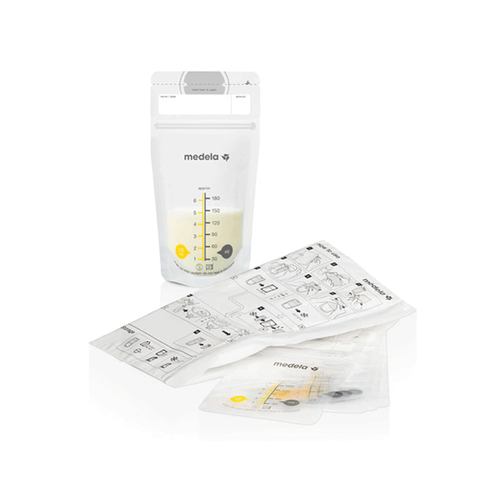

Benefits for Mom
- Durable materials
- Double zipper
- Self-standing
- Easy-to-read measurement marks
- Holds 6 oz
- Hygienically Pre-Sealed and Ready to Use
- BPA Free
What Do Moms Say?
"Perfect bags! They have some textured grip towards the top of the opening.. which is great if your hands tend to be dry from all the hand washing you do." – Erika K.
“Love them, they don't leak, easy to open and reseal. Keep milk safe and secure. Large area at the top to write date, time and amount.” – Michelle G
Motif Medical Easy Pour Breast Milk Storage Bags
Motif Easy Pour Breast Milk Storage Bags are designed to make storing milk as simple as possible without any messes. The easy-pour spout makes it easy to transfer milk, plus these bags are compatible with any bottle. Don't worry about spills; the double zipper lock is leakproof. Easily label your milk at the top and conveniently store your milk in the fridge with its standalone design or lay them down in the freezer. Plus, with the ability to store up to eight ounces of milk, Motif bags allow you to store more in a single bag.


Benefits for Mom
- Compatible with Motif Pump-to-Bag Adapter
- Easy-pour spout
- Double-zipper lock
- Self-standing
- BPA-free
- Stores 8 oz
- Compatible with any bottle
- Space for labeling
- Includes measurement lines
What Do Moms Say?
"I love these bags because of the easy tear and pour! So easy to use and store and keep things clean." – Amanda
"These bags are great! They come with a spout to pour from which is a neat feature. I've never had any issues with spills or leaks. Will continue to use!" – Emily
"I like how they are able to stand, so when looking for dates it's easy. Also, the fact that it has a tear-off so you can pour is amazing! With other bags, I would end up spilling some of my liquid gold [when] opening them from the top. Highly recommend!" – Yahaira G.
Lansinoh Breast Milk Storage Bags & Adaptors
Lansinoh Breast Milk Storage Bags come with an adapter to pump directly into the bags! You will need the pump adapter to pump into the bags if you use a Medela, Evenflo, or Ameda. You will not need the adapter if you use a Spectra or Lansinoh pump. These bags are incredibly durable, with a labeling tab at the top to prevent puncturing them as you write. The Click 'n' Secure closure features a double zipper seal to prevent leaks and spills. Lansinoh bags can be laid flat for easy storage.
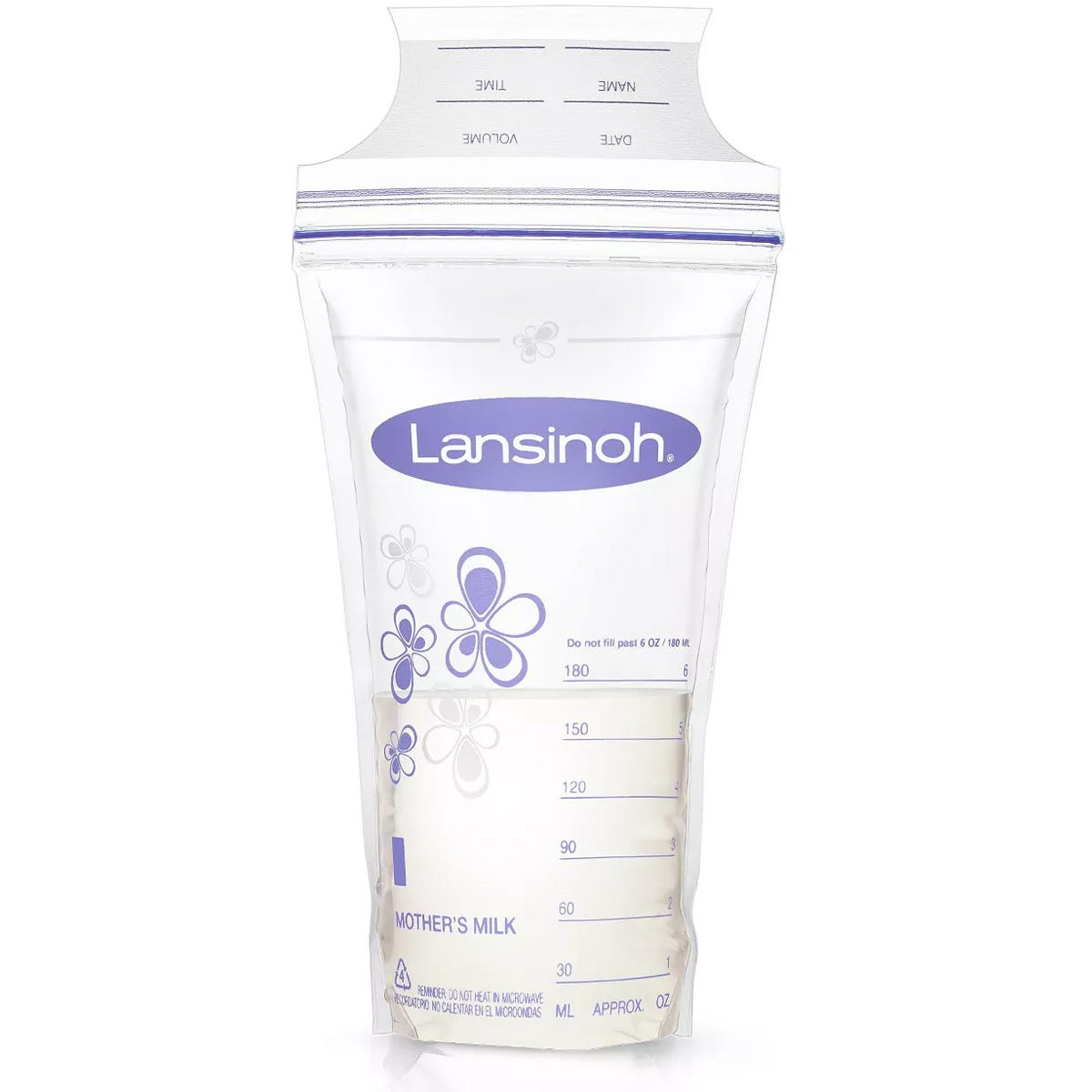

Benefits for Mom
- Includes pump adaptors for direct pumping
- Pour spout
- BPA- and BPS-free
- Puncture-safe labeling tab
- Includes measurement lines
- Double Click 'n' Secure seal
- Can lay flat
- Tamper-evident, tear-away top
What Do Moms Say?
"These bags really save space in the freezer and help organize my milk supply. My two complaints are that when you pour into the bag, you need to know the amount you are pouring in from the start because the measurements aren't accurate on the bags since they compress so easily. Also, they are kind of difficult to pour in and out of. But they are definitely worth it!" – Marina V.
“Durable, freeze and unfreeze fast.” – Earlene G.
“Holds up to 6 ounces per bag with room to freeze, never had any sealing/leaking issues. Gets the job done and affordable compared to other brands of similar quality.” – Sophia P.
Kiinde Twist Pouches
Kiinde Twist Pouches have a twist-lock design to help pump, store, and feed with a single pouch. This way, with the right adaptor you can pump directly into the bag and securely store it in the fridge or freezer without worrying about leaks. Uniquely designed, these bags help you save the time spent transferring from one bag to a bottle, preserving nutrition in the process.
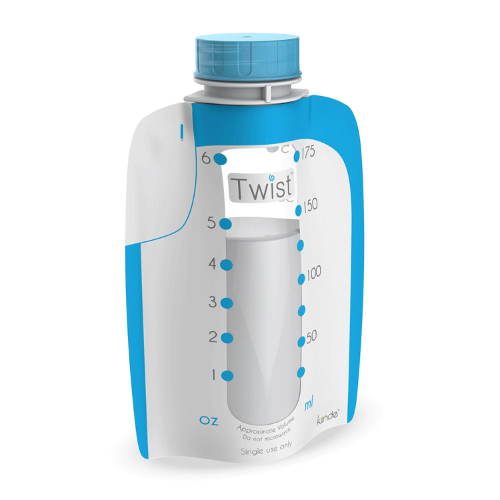

Benefits for Mom
- Can be used for feedings
- Recyclable, BPA-, PVC-, and phthalate-free
- Labeling surface
- Includes measurement lines
- Twist-locks onto pumps w/adaptors for leak-free, transfer-free pumping directly into the pouch
- Self-standing
- Snaps into the Kiinde Squeeze Natural Feeding Bottle
What Do Moms Say?
"The best storage bags, even better than the Nuk. Nuk storage bags are high on my list, but they are flimsy and a pain to unload without splashing the milk all over. For this reason, I love Twiist. They are more expensive, for sure, but to me they are worth it. The construction is superb. They never leak. Freeze well. Markings are accurate and clear to read. They hold shape, allowing them to be stored upright on a fridge shelf. I pump straight into them, with a correct pump attachment, so they save me loads of time, eliminating the need to wash bottles, pour milk from bottles to bags, etc. I highly recommend even if you don't use the Kiinde system." – Sasha C.
"I love these storage bags! So easy to just pump straight into them and attach it to the bottle. Bonus that I can just throw it away after a feeding and can avoid having to wash another bottle!" – Shailor H.
"I have used Kiind and Tommy Tippee storage bags. These bags have thicker plastic and the seams are sealed well. The adapters fit nicely. Storage bags that fit directly onto the pump are massively convenient for the sessions where I know I'm pumping for my freezer stash. If I am pumping for daycare or bottles at home, I pump directly into bottles. The only thing I don't like about the Kiind bags is that there is no marking between the ounce/ml volume markings so you just have to eyeball how much you think is in the bag (e.g. 3.5 vs. 3.8oz is hard to tell), but trying to guess amounts in storage bags always has some margin of error. The bags stand up, which is awesome!! Just don't stand them up without a cap on for too long and accidentally knock over/spill your milk!! The bags are recyclable and single-use." – Stephanie
Spectra Disposable Milk Bags
Have confidence that your milk will stay fresh with the Spectra Disposable Milk Bags. They are double-lined to prevent leaks and zip-closed for a tight seal. They're self-standing with a compact design that is perfect for storage. Use the measurement scale to instantly see how much milk the bag contains to know exactly how much you're feeding your baby.
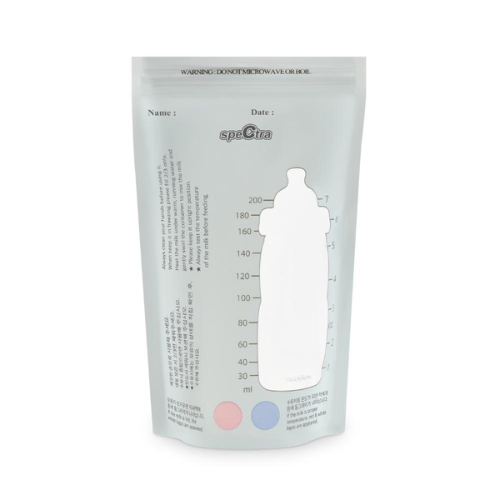

Benefits for Mom
- BPA-free
- Double-lined
- Self-standing
- Zip top for a tight seal
- Includes measurement lines
- Space for labeling
- Holds 200 mL
What Do Moms Say?
“I like how these bags are sealed and sterile until you open them. Make sure the bottom of the bag is fully open to let the milk get all the way to the bottom to get an accurate amount of how much is in the bag.” – Erin D.
“These are great! They sit up on their own and they have a temperature gauge on them. I would highly recommend!” – Erin D.
“Affordable price, fast shipping! Love the product.” – Vidisha S.
Evenflo Advanced Breast Milk Storage Bags
Evenflo Advanced Milk Storage Bags are made of durable, military-grade material and are 30% thinner, which makes freezing and thawing faster, saving you some extra time. Evenflo bags are self-standing and can lay flat for quick and easy storage. The labeling tab is at the top for puncture-free writing and you can use the easy-pour spout to instantly transfer milk without losing a single drop.
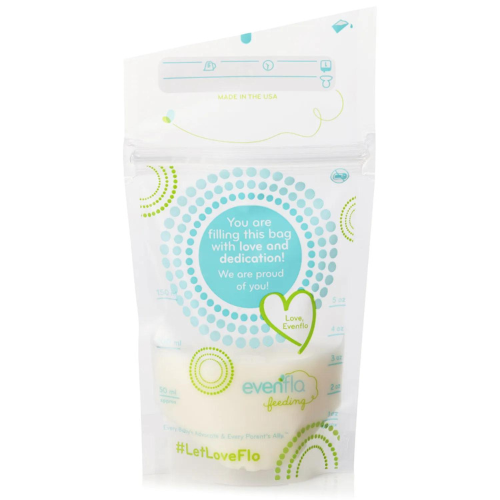

Benefits for Mom
- Self-standing
- Pour spout
- Made of durable, yet 30% thinner material to reduce waste
- Has a quicker freeze/thaw time
- SafeZip dual-track zipper seal
- Puncture-free label
- Includes measurement lines
- Holds 5 oz
What Do Moms Say?
"I used these bags over the course of a few weeks. Upon receipt, I thought that the material was very thin and would prove to be weak; however, I was wrong. The bag material was deceptively strong and withstood a couple of drops, as well as cross-country travel. I enjoyed the encouraging message on the side of the bag and appreciated the ability to pump directly in the bag with an adapter to my pump. I do wish that there was some method of signaling the bag is completely sealed. Maybe a change in color of the seal similar to regular plastic bags." – MomofT2
"I really like [these] bags. I've been using them for a while now and I love the ease of use, the soft plastic, and the encouragement notes on them. They are very cute!" - Cecibryan
"I have used a variety of milk storage bags. Some are very thick, some are very flimsy, some are tough to poor or don't freeze flat. Recently, I went on a trip and had to freeze all my milk and fly home with it. I used these bags and had a great experience! They freeze quickly – in a little tiny hotel fridge freezer! They stayed frozen in a cooler for 8 hours traveling home, and now using them is a breeze. They are very easy to thaw and the spout makes it a piece of cake to transfer to a bottle! I only wish they were a bit sturdier when standing in their own." – Sunshine2151
Get Breastfeeding Support
Do you have any additional questions about how to mix breast milk that have not been addressed? You may consider working with a pregnancy and breastfeeding consultant. Some insurance providers cover pregnancy and breastfeeding classes and one-on-one consultations.
Fill out this form to see if you qualify.
References
- Breastmilk Storage and Handling. www.kellymom.com. Last updated March 2018.
- Frequently Asked Questions from the CDC. Breastfeeding. Last reviewed August 2021.
- Igumbor, E O et al. “Storage of breast milk: effect of temperature and storage duration on microbial growth.” The Central African journal of medicine vol. 46,9 (2000): 247-51. doi:10.4314/cajm.v46i9.8564
- Motherly. 2022. Motherly – A wellbeing brand empowering mothers to thrive.. [online] Available at: https://www.mother.ly/life/slacker-boob/' [Accessed 26 September 2022].
- https://www.cdc.gov/breastfeeding/breast-milk-preparation-and-storage/handling-breastmilk.html



